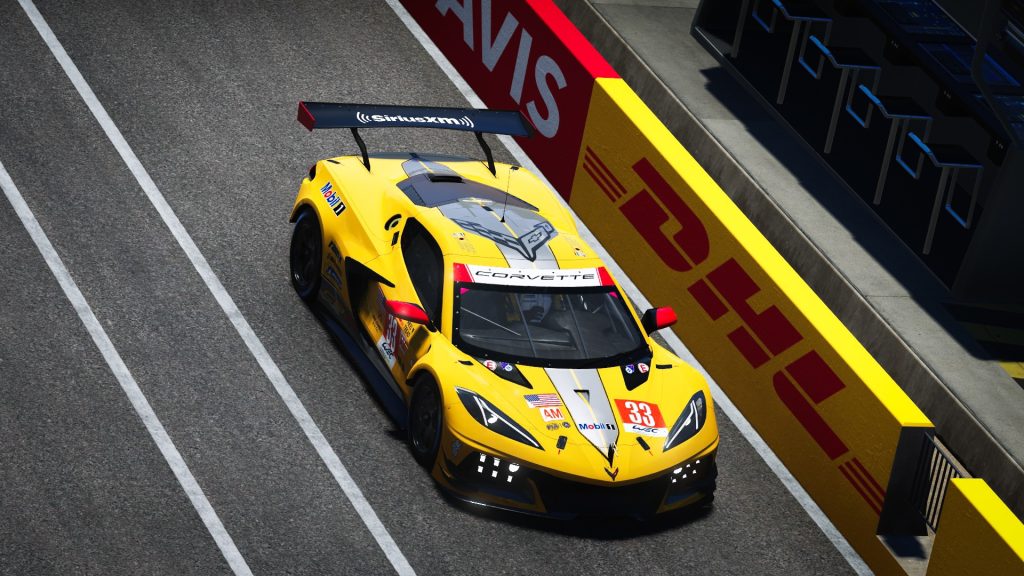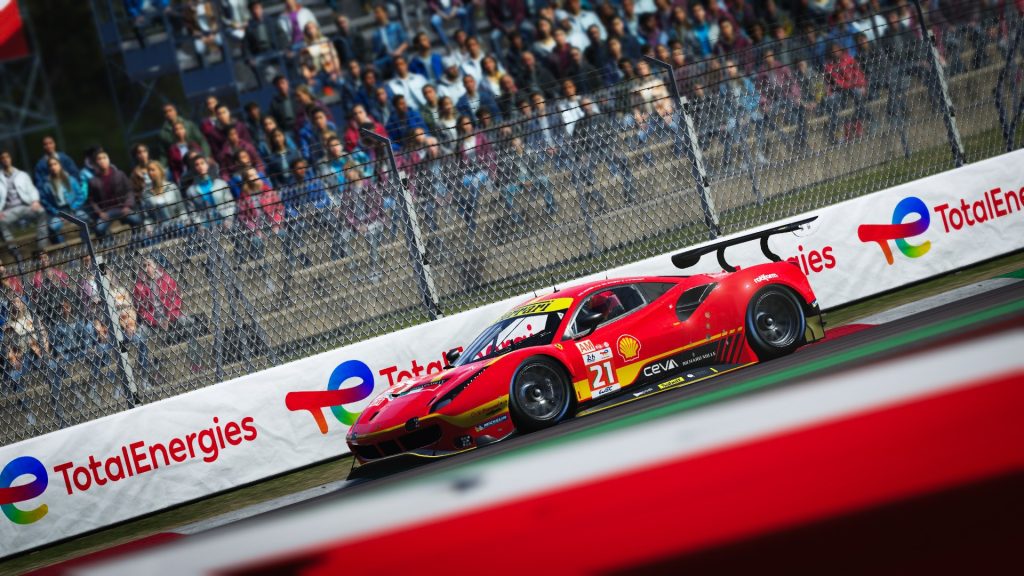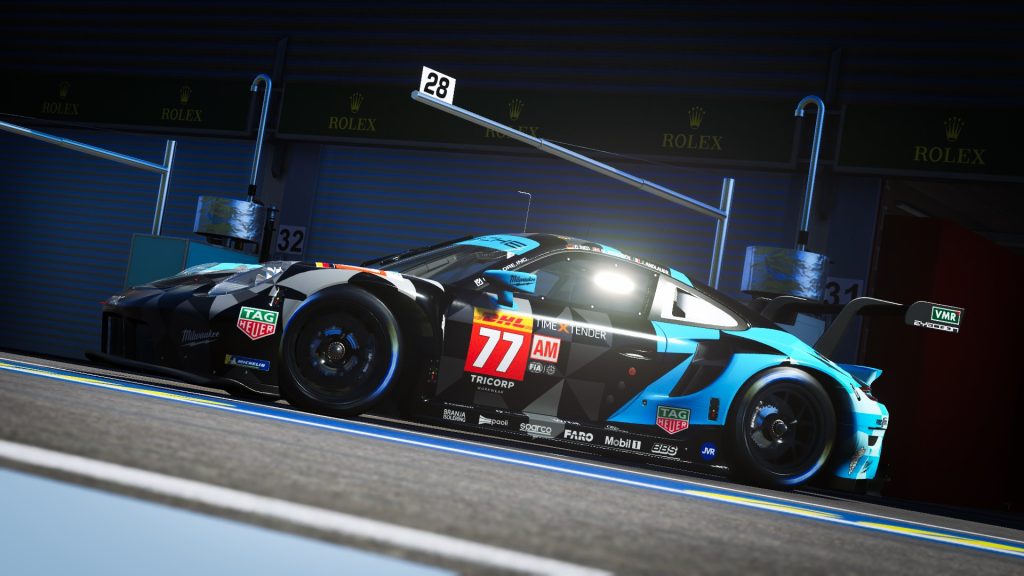Whilst Le Mans Ultimate’s roster of seven Hypercars stole headlines upon its release, equal quality can be found amongst the LMGTE fields which completes the 2023 World Endurance Championship grid alongside the Hypercars and LMP2.
2023 marked the final time GTE cars would race in WEC, being phased out for the 2024 season in favour of the LMGT3 category that utilises GT3 machinery. So you can think of their inclusion in Le Mans Ultimate as their final hurrah in sim racing – the GTE class lost interest a long time ago in iRacing.
If you find the cold tyres and complex energy recovery systems of Hypercars too much to handle, then the purer driving experiences offered by the four GTE challengers might be the perfect fit for your needs.
What is the LMGTE AM class?
The LMGTE AM class sits at the bottom of the pile regarding pace in Le Mans Ultimate, representing the only non-prototype category. It uses GTE specification cars, which are similar to GT3s but feature more power, less weight and greater levels of downforce. In 2023, four esteemed marques – Aston Martin, Chevrolet, Ferrari and Porsche – had their machines on track courtesy of LMGTE AM.
Before we dive into Le Mans Ultimate’s selection of GTE cars, let’s learn a little bit more about the class’ history.
LMGTE first appeared in sportscar racing in 2011 after the ACO made a myriad of adjustments to its GT-based categories, introducing LMGTE Pro and LMGTE AM to the endurance racing world. The change attracted new cars from Ferrari, Aston Martin, Chevrolet and BMW, just to name a few, and the class was popular from the outset.
Despite more adjustments in 2016, things remained that way in both the WEC and IMSA as the 2020s rolled around until numbers began to dwindle in LMGTE Pro, which was specifically for factory-run entires and professional drivers. The category was phased out of the WEC at the end of 2022, leaving only LMGTE AM, which was built on customer teams and a mixture of professional and amateur drivers, still on the grid. But it was also on borrowed time, set to be replaced by LMGT3 for 2024.
The GTE cars in Le Mans Ultimate
All four GTE specification cars that were on the WEC grid can be driven in Le Mans Ultimate. Levelled by a Balance of Performance system (BoP) just like Hypercar, LMGTE AM pits completely juxtaposing styles of cars up against each other, opening the door for the front-engined Aston Martin Vantage, Porsche’s rear-engined 911 GTE RSR and anything in between – variety is the spice of life, as they say.
Here are the GTE cars that are present in Le Mans Ultimate:
- Aston Martin Vantage AMR
- Chevrolet Corvette C8.R
- Ferrari 488 GTE Evo
- Porsche 911 RSR-19
GTE cars aren’t new to the sim racing world, found in titles such as iRacing, Assetto Corsa, Automobilista 2 and even Studio 397’s own rFactor 2. But Le Mans Ultimate’s rendition of them has its subtleties, of course.
Overall, GTEs are closer aligned with LMP2 rather than Hypercar in their basic characteristics. Once again, cold tyres aren’t such a massive hurdle and braking is much easier to get to grips with, despite not featuring ABS. The GTE category also features TC, although traction is surprisingly difficult at lower speeds which is something to watch out for.
So focused on mechanical grip, though, driving any car from LMGTE AM is an incredibly fun experience: they all respond best when you take your tyre-saving hat off and attack them at their limit.
Aston Martin Vantage AMR

| Car | Ruleset | Engine |
| Aston Martin Vantage AMR | GTE | 4-litre twin turbocharge V8 |
Prestigious British manufacturer Aston Martin has been a staple of GT racing since it first entered a race-ready version of the V8 Vantage in 2008 and the 2018 V8 Vantage GTE featured in Le Mans Ultimate is no stranger to success.
It’s taken 14 LMGTE Pro or LMGTE AM victories since its debut, notably winning the 2019-2020 LMGTE Pro title with Marco Sorensen, Nicki Thiim and Richard Westbrook, as well as the 2022 LMGTE AM championship with TF Sport.
However, wins have been more sparse for the Aston Martin GTE in the last few years despite a strong three-car presence in LMGTE AM. ORT by TF, NorthWest AMR and D’Station Racing finished fifth, ninth and 12th respectively in 2023 despite taking four podiums between them.
In Le Mans Ultimate, the V8 Vantage feels surprisingly nimble given its front-engined layout. On a default setup, the rear end feels extremely light and easy to overcome, which means you can’t push it safely quite as heavily as some of its rival GTE cars. Overall, it provides a solid base to work from, but during our testing, we found that it was difficult to get to grips with straight out of the box.
Here are the Aston Martin’s key characteristics:
- Front-engined nature doesn’t seem to hold it back
- Easy to overcome the rear end
Chevrolet Corvette C8.R

| Car | Ruleset | Engine |
| Chevrolet Corvette C8.R | GTE | 5.5-litre naturally-aspirated V8 |
Having raced at Le Mans every year since 2000, Chevrolet are seasoned endurance veterans with the Corvette platform.
The mid-engined C8.R that features in Le Mans Ultimate was first introduced in 2020 and made its debut in the 24 Hours of Daytona across the pond. It competed in the WEC sporadically during its first two years of service before appearing full-time in LMGTE Pro in 2022, the #64 car finishing the season sixth with one win and two podiums.
As star drivers Nick Tandy and Alexander Sims switched to Hypercar in 2023 and the LMGTE Pro class was brought to a close, the squad migrated its programme to LMGTE AM and took on the mighty Nicky Catsbury, Ben Keating and Nicolas Varrone. Ultimate success would follow as the trio scored three wins and a second-place over the first four races over the year to secure the title at Monza two rounds early – the perfect send-off before LMGT3.
However, the C8.R’s virtual translation does not always carry the same level of competitiveness. To its merit, it is by far the most stable and reliable GTE car in Le Mans Ultimate but it struggles with manoeuvrability. Its straight-line speed is also notably weak, which will hurt at tracks such as Fuji and Monza.
These are the C8.R key characteristics:
- Stable and predictable
- Feels heavy
- Slow in a straight line
Ferrari 488 GTE Evo

| Car | Ruleset | Engine |
| Ferrari 488 GTE Evo | GTE | 4-litre twin-turbocharged V8 |
The prancing horse has always been a regular visitor to the top step of the podium in GT racing and the mid-engined Ferrari 488 GTE Evo certainly continued that legacy over its time in the WEC.
Since its first season in 2018, the 488 GTE Evo picked up a stunning four LMGTE Pro or LMGTE AM championship victories, including that win against Porsche for the final LMGTE Pro title in 2022.
With a storied history, the 488 GTE Evo has become an iconic image of Ferrari’s modern success and its seven 2023 LMGTE AM entries are stunning in the virtual world.
In Le Mans Ultimate, the 488 GTE Evo is the most competitive option of the four GTE runners. It feels agile and pointy which will give you the confidence in the front end that you need, and it performs well across the majority of corner types. Unlike the Corvette, it is also strong in a straight line.
However, on the flip side, it is inherently slippery at the rear end. You have to be hyperaware of your inputs in slower-speed corners where downforce isn’t on your side; too much steering angle will, very simply, leave you facing the wrong way.
This is in contrast to the rear-engined Porsche 911 RSR-19, though, which is known for suffering from lift-off and entry oversteer at medium and high speeds because the 488 GTE Evo’s problem seems to be rooted in its default mechanical setup.
Nevertheless, if you can get on top of these issues, the 488 GTE Evo is Le Mans Ultimate’s fastest GTE car.
Here are its key characteristics:
- Pointy and nimble
- Best all-around car
- Suffers from a light rear-end
Porsche 911 RSR-19

| Car | Ruleset | Engine |
| Porsche 911 RSR-19 | GTE | 4-litre naturally-aspirated flat-six |
Porsche’s 911 RSR-19 is equally as well-regarded for its success in the GTE category as the Ferrari 488 GTE Evo.
Based on the 991.2 road-going Porsche 911 platform, the RSR-19 was introduced as a refinement to the already successful 2017 rendition of the car that marked some key milestones for Porsche in GTE – for the first time since the 911 GT1 of the late 1990s, Porsche placed their engine in front of the rear axle, for example, to better weight distribution and handling.
Over its four-season lifetime, the RSR-19 has given way to many iconic moments, most recently in the hands of the Iron Dames team which won the last-ever GTE race in 2023 and simultaneously became the first all-female squad to win a race in the WEC.
The RSR-19 is a strong choice on the virtual track in Le Mans Ultimate, notably striking a good balance between having strong rotation without being overly difficult to handle.
Of course, it carries all of the regular characteristics of a Porsche, excelling in acceleration thanks to its screaming flat-six engine, being strong at low speed but needing to be balanced carefully on corner entries.
Here are the Porsche 911 RSR-19’s key features:
- Well balanced but geared slightly more towards oversteer
- Excellent acceleration
- Good rotation








